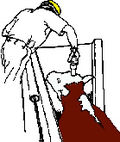Animal slaughter
The process of killing animals for food and other products
Overview[edit]
Animal slaughter is the process of killing animals, primarily for the purpose of providing food. It is a critical component of the meat industry and involves various methods and practices to ensure the humane treatment of animals, as well as the safety and quality of the meat products.
Methods of Slaughter[edit]
The methods of animal slaughter can vary significantly depending on cultural, religious, and legal standards. Common methods include:
Stunning[edit]
Stunning is a technique used to render animals unconscious before slaughter to minimize pain and distress. Methods of stunning include:
- Electrical stunning: Used primarily for poultry and pigs, where an electric current is passed through the animal's brain.
- Captive bolt stunning: Commonly used for cattle, where a bolt is driven into the animal's brain.
- Gas stunning: Involves the use of gases such as carbon dioxide to render animals unconscious.
Bleeding[edit]
After stunning, animals are typically bled by cutting the major blood vessels in the neck. This process, known as exsanguination, ensures the animal dies quickly and the meat is properly drained of blood.
Religious Slaughter[edit]
Certain religious practices have specific requirements for slaughter, such as:
- Halal: In Islam, animals must be slaughtered by cutting the throat while invoking the name of Allah.
- Kosher: In Judaism, animals must be slaughtered by a trained individual known as a shochet, following specific guidelines.
Animal Welfare[edit]
Animal welfare is a significant concern in the slaughter process. Regulations and guidelines are in place in many countries to ensure humane treatment. Organizations such as the World Organisation for Animal Health (OIE) provide standards for the humane slaughter of animals.
Environmental Impact[edit]
The slaughter of animals has environmental implications, including the management of waste products and the carbon footprint of meat production. Efforts are being made to reduce the environmental impact through sustainable practices and technologies.
Cultural and Ethical Considerations[edit]
Animal slaughter is a topic of ethical debate, with discussions focusing on animal rights, the necessity of meat consumption, and the environmental impact of meat production. Cultural practices and traditions also play a significant role in how slaughter is perceived and conducted.
Related Pages[edit]
-
The Butcher and his Servant drawn and engraved by J Amman Sixteenth Century
-
Rembrandt, bue squartato, 1655
-
Richardson's abattoir
-
Stunning with captive bolt gun
-
Killing hen for lunch
-
Animal transport
-
Uccisione del maiale
Ad. Transform your life with W8MD's Budget GLP-1 injections from $75


W8MD offers a medical weight loss program to lose weight in Philadelphia. Our physician-supervised medical weight loss provides:
- Weight loss injections in NYC (generic and brand names):
- Zepbound / Mounjaro, Wegovy / Ozempic, Saxenda
- Most insurances accepted or discounted self-pay rates. We will obtain insurance prior authorizations if needed.
- Generic GLP1 weight loss injections from $75 for the starting dose.
- Also offer prescription weight loss medications including Phentermine, Qsymia, Diethylpropion, Contrave etc.
NYC weight loss doctor appointmentsNYC weight loss doctor appointments
Start your NYC weight loss journey today at our NYC medical weight loss and Philadelphia medical weight loss clinics.
- Call 718-946-5500 to lose weight in NYC or for medical weight loss in Philadelphia 215-676-2334.
- Tags:NYC medical weight loss, Philadelphia lose weight Zepbound NYC, Budget GLP1 weight loss injections, Wegovy Philadelphia, Wegovy NYC, Philadelphia medical weight loss, Brookly weight loss and Wegovy NYC
|
WikiMD's Wellness Encyclopedia |
| Let Food Be Thy Medicine Medicine Thy Food - Hippocrates |
Medical Disclaimer: WikiMD is not a substitute for professional medical advice. The information on WikiMD is provided as an information resource only, may be incorrect, outdated or misleading, and is not to be used or relied on for any diagnostic or treatment purposes. Please consult your health care provider before making any healthcare decisions or for guidance about a specific medical condition. WikiMD expressly disclaims responsibility, and shall have no liability, for any damages, loss, injury, or liability whatsoever suffered as a result of your reliance on the information contained in this site. By visiting this site you agree to the foregoing terms and conditions, which may from time to time be changed or supplemented by WikiMD. If you do not agree to the foregoing terms and conditions, you should not enter or use this site. See full disclaimer.
Credits:Most images are courtesy of Wikimedia commons, and templates, categories Wikipedia, licensed under CC BY SA or similar.
Translate this page: - East Asian
中文,
日本,
한국어,
South Asian
हिन्दी,
தமிழ்,
తెలుగు,
Urdu,
ಕನ್ನಡ,
Southeast Asian
Indonesian,
Vietnamese,
Thai,
မြန်မာဘာသာ,
বাংলা
European
español,
Deutsch,
français,
Greek,
português do Brasil,
polski,
română,
русский,
Nederlands,
norsk,
svenska,
suomi,
Italian
Middle Eastern & African
عربى,
Turkish,
Persian,
Hebrew,
Afrikaans,
isiZulu,
Kiswahili,
Other
Bulgarian,
Hungarian,
Czech,
Swedish,
മലയാളം,
मराठी,
ਪੰਜਾਬੀ,
ગુજરાતી,
Portuguese,
Ukrainian





